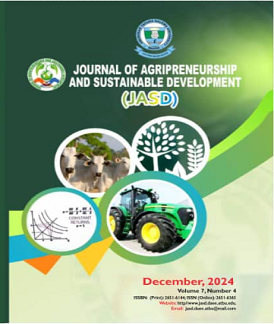EFFECT OF MICROFINANCE BANKS LOAN ACCESSIBILITY ON WOMEN CASSAVA PROCESSOR’S WELFARE STATUS IN SOUTHWEST NIGERIA: AN ENDOGENOUS SWITCHING REGRESSION APPROACH
Keywords:
Accessibility, Cassava, Microfinance, Welfare and WomenAbstract
The study estimates the effect of microfinance credit loan on women cassava processor’s welfare in southwest Nigeria. An endogenous switching regression model was adopted to control for a possible selection bias due to unobserved factors. Multistage sampling was used to select 200 respondents and semi-structured questionnaire augmented with scheduled interview was used to retrieve information. It was found that access to credit (especially microfinance loans) was generally low. Welfare status was also low across the respondents as the majority of the processors (95%) are in the lower boundary welfare status. The endogenous switching regression results confirmed the presence of both a positive and negative selection bias. In general, the results showed that microfinance loan significantly (p<0.05) affects the outcome of both groups. Households who are beneficiaries would have had a drop in welfare of about 10.3% less if they had not opted for the microfinance loan i.e. ATT. Similarly, households who are non-beneficiaries would have earned about 33.1% in welfare increase if they had opted for micro loans, i.e. ATU. This welfare increase gained due to participation in micro loans and the potential benefits indicates that getting a microfinance loan has a strong positive and significant effect on welfare. As a result, it is recommended that government agencies and financial institutions should collaborate with pertinent stakeholders to create policies that reduce barriers to accessing microfinance loans for cassava processing women. This could include lowered interest rate, provision of securities and guarantees, and simplification of loan applications and assessment.
Downloads
Downloads
Published
How to Cite
Issue
Section
License
Copyright (c) 2025 Journal of Agripreneurship and Sustainable Development

This work is licensed under a Creative Commons Attribution 4.0 International License.



